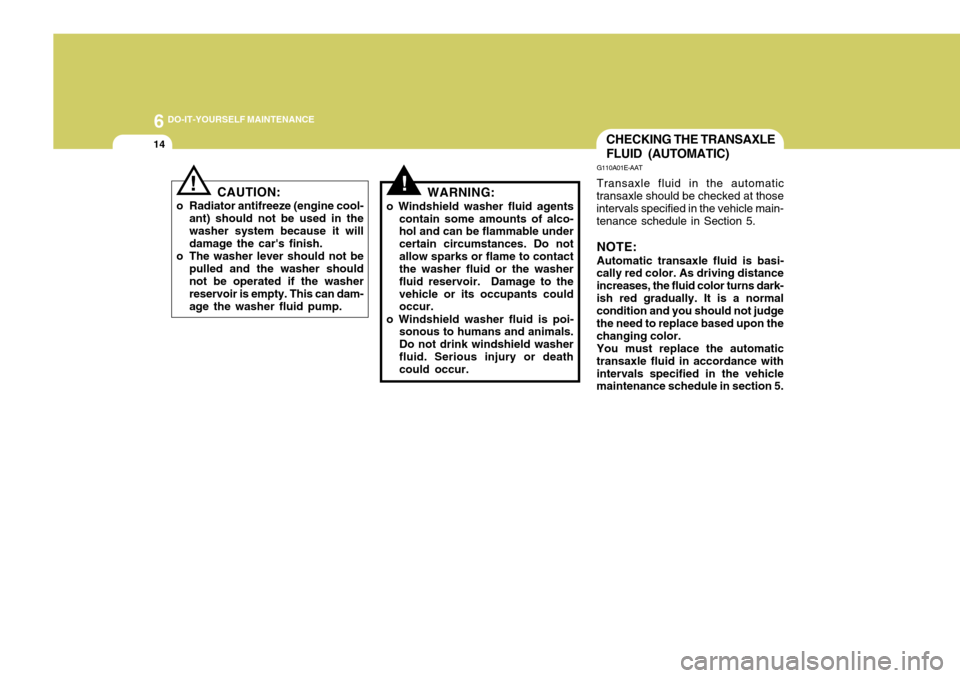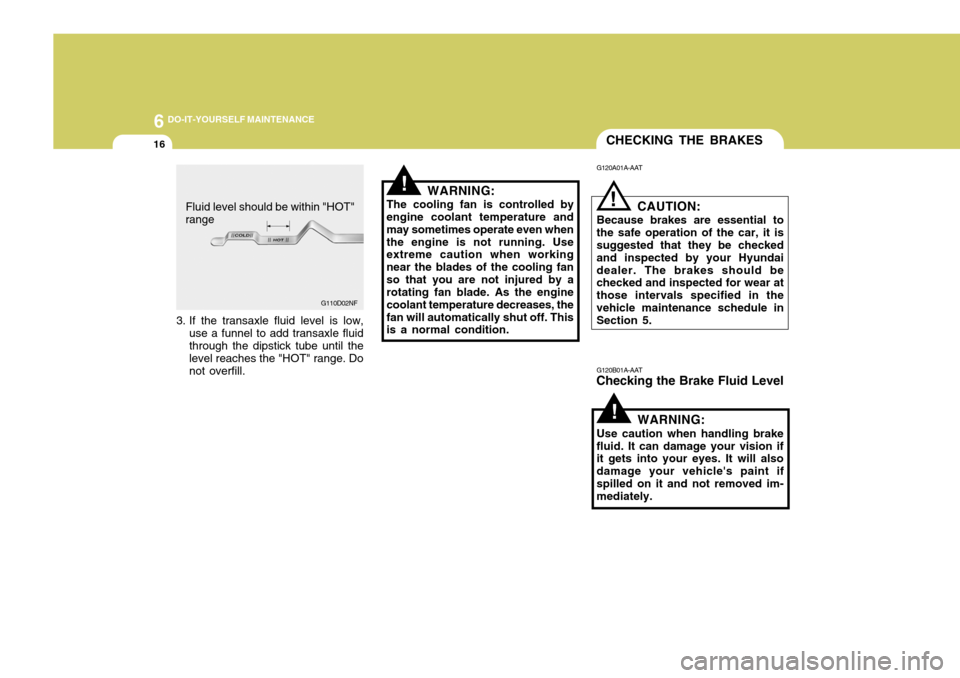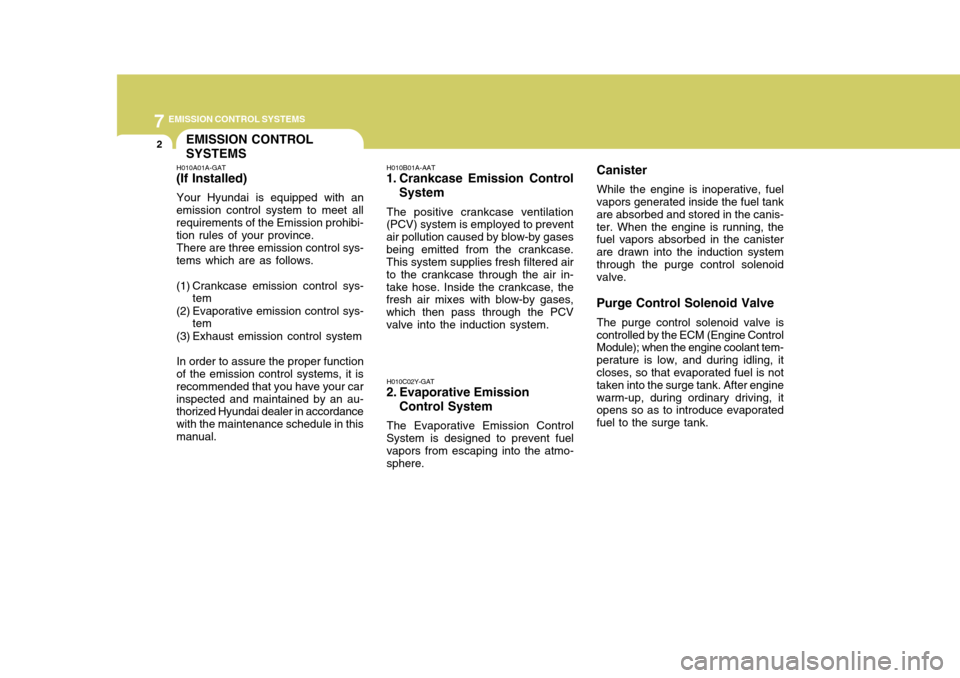2005 Hyundai Azera maintenance schedule
[x] Cancel search: maintenance schedulePage 235 of 297

5VEHICLE MAINTENANCE REQUIREMENTS
8
F060H01A-AAT
o Air Cleaner Filter A Genuine Hyundai air cleaner filter is recommended when filter is replaced. F060J01A-AAT o Spark Plugs Make sure to install new spark plugs of the correct heat range. F070C01A-AAT
o Coolant
The coolant should be changed at the intervals specified in the mainte- nance schedule.
Inspect the hose routing to assure thatthe hoses do not come in contact withany heat source, sharp edges or mov- ing component which might cause heat damage or mechanical wear. Inspectall hose connections, such as clamps and couplings, to make sure they are secure, and that no leaks are present.Hoses should be replaced immedi- ately if there is any evidence of dete- rioration or damage.
F070F01A-AAT
o Brake Hoses and Lines
Visually check for proper installation,
chafing, cracks, deterioration and anyleakage. Replace any deteriorated or damaged parts immediately. F070E04A-AAT
o Automatic Transaxle Fluid
The fluid level should be in the "HOT"
range of the dipstick, after the engineand transaxle are at normal operating temperature. Check the automatictransaxle fluid level with the engine running and the transaxle in neutral, with the parking brake properly ap-plied.
Use HYUNDAI GENUINE ATF SP III,
DIAMOND ATF SP III, SK ATF SP III or other brands approved by Hyundai Motor Co., when adding or changingfluid.
F060N02E-AAT
o Valve Clearance
Inspect excessive valve noise and/orengine vibration and adjust if neces- sary. A qualified technician should perform the operation. F070B01A-GAT
o Cooling System
Check the cooling system part, such as radiator, coolant reservoir, hosesand connections for leakage and dam- age. Replace any damaged parts.
Page 245 of 297

6
DO-IT-YOURSELF MAINTENANCE
9
!WARNING:
The cooling fan is controlled by engine coolant temperature and may sometimes operate even when theengine is not running. Use extreme caution when working near the blades of the coolant fan so that youare not injured by a rotating fan blade. As the engine coolant tem- perature decreases, the fan will au-tomatically shut off. This is a nor- mal condition.
SPARK PLUGS
G060A01TG-GAT
G060A01L
Your engine was originally equipped with Iridium-tipped spark plugs (For unleaded only).Iridium-tipped spark plugs will lastlonger than conventional type sparkplugs and can be identified by blue lines on the ceramic shell. NOTE: Do not clean or regap Iridium- tipped spark plugs. G060B01TG-GAT Replacing the Spark Plugs The spark plugs should be changed at the intervals specified in the ve- hicle maintenance schedule in Sec- tion 5 or whenever engine perfor-mance indicates they should be changed. Symptoms that suggest poor spark plug performance include en-gine misfiring under load, loss of fuel economy, poor acceleration, etc. When spark plugs are replaced, al-ways use spark plugs recommended by Hyundai. The use of other spark plugs can result in loss of perfor-mance, radio interference or engine damage. NOTE:
o It is recommended that spark
plugs should be changed by an authorized Hyundai dealer.
o When replacing the spark plugs,
always use the genuine parts rec- ommended.
Unleaded : 1.0~1.1 mm Leaded : 0.7~0.8 mm
Page 250 of 297

6 DO-IT-YOURSELF MAINTENANCE
14
CAUTION:
o Radiator antifreeze (engine cool- ant) should not be used in the washer system because it will damage the car's finish.
o The washer lever should not be pulled and the washer shouldnot be operated if the washer reservoir is empty. This can dam-age the washer fluid pump.
!
CHECKING THE TRANSAXLE FLUID (AUTOMATIC)
G110A01E-AAT Transaxle fluid in the automatic
transaxle should be checked at those intervals specified in the vehicle main-tenance schedule in Section 5.
NOTE: Automatic transaxle fluid is basi-
cally red color. As driving distance increases, the fluid color turns dark-ish red gradually. It is a normal condition and you should not judge the need to replace based upon thechanging color.
You must replace the automatic
transaxle fluid in accordance withintervals specified in the vehicle maintenance schedule in section 5.
!WARNING:
o Windshield washer fluid agents contain some amounts of alco- hol and can be flammable under certain circumstances. Do notallow sparks or flame to contact the washer fluid or the washer fluid reservoir. Damage to thevehicle or its occupants could occur.
o Windshield washer fluid is poi- sonous to humans and animals. Do not drink windshield washerfluid. Serious injury or death could occur.
Page 252 of 297

6 DO-IT-YOURSELF MAINTENANCE
16
!
!
G110D02NF
Fluid level should be within "HOT"
range WARNING:
The cooling fan is controlled by engine coolant temperature and may sometimes operate even whenthe engine is not running. Use extreme caution when working near the blades of the cooling fanso that you are not injured by a rotating fan blade. As the engine coolant temperature decreases, thefan will automatically shut off. This is a normal condition.
3. If the transaxle fluid level is low,
use a funnel to add transaxle fluid through the dipstick tube until the level reaches the "HOT" range. Do not overfill.
CHECKING THE BRAKES
G120A01A-AAT G120B01A-AAT
Checking the Brake Fluid Level
! CAUTION:
Because brakes are essential to the safe operation of the car, it is suggested that they be checked and inspected by your Hyundaidealer. The brakes should be checked and inspected for wear at those intervals specified in thevehicle maintenance schedule in Section 5.
WARNING:
Use caution when handling brake fluid. It can damage your vision if it gets into your eyes. It will also damage your vehicle's paint ifspilled on it and not removed im- mediately.
Page 279 of 297

7EMISSION CONTROL SYSTEMS
2EMISSION CONTROL SYSTEMS
H010A01A-GAT
(If Installed)
Your Hyundai is equipped with an
emission control system to meet all requirements of the Emission prohibi- tion rules of your province.
There are three emission control sys-
tems which are as follows.
(1) Crankcase emission control sys- tem
(2) Evaporative emission control sys- tem
(3) Exhaust emission control system
In order to assure the proper function
of the emission control systems, it is recommended that you have your carinspected and maintained by an au- thorized Hyundai dealer in accordance with the maintenance schedule in thismanual. H010B01A-AAT
1. Crankcase Emission Control
System
The positive crankcase ventilation
(PCV) system is employed to preventair pollution caused by blow-by gasesbeing emitted from the crankcase. This system supplies fresh filtered air to the crankcase through the air in-take hose. Inside the crankcase, the fresh air mixes with blow-by gases, which then pass through the PCVvalve into the induction system.
H010C02Y-GAT
2. Evaporative Emission
Control System
The Evaporative Emission Control
System is designed to prevent fuelvapors from escaping into the atmo-sphere. Canister
While the engine is inoperative, fuel
vapors generated inside the fuel tankare absorbed and stored in the canis-ter. When the engine is running, the fuel vapors absorbed in the canister are drawn into the induction systemthrough the purge control solenoid valve. Purge Control Solenoid Valve
The purge control solenoid valve is
controlled by the ECM (Engine Control Module); when the engine coolant tem- perature is low, and during idling, it closes, so that evaporated fuel is not taken into the surge tank. After enginewarm-up, during ordinary driving, it opens so as to introduce evaporated fuel to the surge tank.
Page 295 of 297

10INDEX
4
G General Checks ........................................................... 6-3
Glove Box ................................................................. 1-95
HHazard Warning System ............................................ 1-83
Headlight
Aiming adjustment .................................................. 6-26
Leveling device system .......................................... 1-82
Bulb replacement .................................................... 6-28
Switch ..................................................................... 1-77
Washer switch ........................................................ 1-82
Heating and Cooling Control ....................................1-113
Heating and Ventilation ............................................ 1-114
Air flow control ........................................... 1-115, 1-128
Air intake control switch ............................ 1-117, 1-126
Air quality control system ..................................... 1-126
Bi-level heating ..................................................... 1-118
Defrosting/Defogging .................................. 1-119, 1-130
Fan speed control (Blower control) ............ 1-115, 1-125
Temperature control ................................... 1-115, 1-127
High-Mounted Rear Stop Light .................................1-103
Hood Release .......................................................... 1-105
Horn ......................................................................... 1-107
I Ignition Switch ............................................................. 2-3
Immobilizer System ..................................................... 1-5
Limp home procedures ............................................. 1-8
Key ........................................................................... 1-5 Instrument Cluster and
Indicator Lights ..................... 1-58
Instrument Panel Light Control (Rheostat) .................1-85
Intergrated Memory System (I.M.S) ..........................1-26
Interior Light ............................................................... 1-93
Intermittent Wiper ...................................................... 1-82
J Jump Starting .............................................................. 3-3
K
Key .............................................................................. 1-4 If you lose your keys ............................................. 3-13
Positions ................................................................... 2-4
L Light Bulbs Repl acement ........................................... 6-28
Light Bulbs Watages ................................................. 6-36
Lubrication Chart .......................................................... 9-4
M Maintenance Intervals Explanation of scheduled maintenance items ......... 5-7
Maintenance under severe usage conditions .......... 5-6 Scheduled maintenance ........................................... 5-4
Service requirements ................................................ 5-2
Maintenance Precautions ............................................ 6-4
Mirrors
Day/night inside rearview mirror .............................. 1-99
Outside rearview m irror ........................................... 1-96
Outside rearview mirror heater ................................1-98